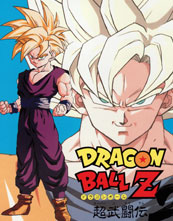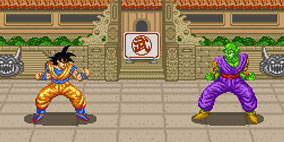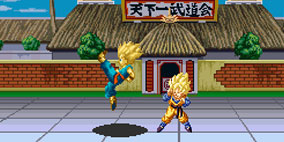
- Developer:
- TOSE Software Co.
- Platforms:
- Super Famicom, Super Nintendo
- Publisher:
- Bandai
- Released:
- December 17, 1993October 20, 2015June 1994June 1994
About Dragon Ball Z Super Butōden 2
ドラゴンボールZ 超武闘伝2 Doragon Bōru Zetto Sūpā Butōden Tsū
Dragon Ball Z Super Butōden 2 is a classic fighting game developed by TOSE Software and released by Bandai for Super Famicom on December 17, 1993 in Japan, and for Super Nintendo on June 1994 in France and Spain. It's a second game in Butōden fighting game series and third Dragon Ball game released on Super Famicom/Super Nintendo at all. Almost 20 years after the release, on 7th November 2013, Super Butōden 2 got a second life becoming a part of J Legend Retsuden, a game compilation for Nintendo 3DS released as part of the 45th anniversary celebration of Weekly Shōnen Jump. Additionally, a digital version of the game was also available as a bonus to pre-ordered Dragon Ball Z Extreme Butōden for Nintendo 3DS.
Overview
The game, like the first (Dragon Ball Z Super Butōden) and third (Dragon Ball Z Super Butōden 3) parts of Super Butōden series is set in one of the important time periods of Dragon Ball Z manga and tv show. However, depending on the chosen character, wins or loses, the story may look a bit different. The game covers events taking place during the Perfect Cell Saga from Gohan's perspective, as well as alternative version of the events from Dragon Ball Z movies with Bojack and Broly.
The combat system looks very similar to the predecessor. Two opponents are fighting on a large stage. The screen splits when the characters move away from each other. On the top of the screen, below health bars, there is a radar, thanks to which the player always knows where the opponent is at the moment. This gives many possible strategies to win the battle. The fight takes place on the ground, in the air, and even underwater - this is the first Dragon Ball game ever with underwater fighting option.
Each character has a set of basic punches, kicks, and Ki blasts which, when properly combined with the D-Pad, can turn into deadly combos. The game also features iconic attacks like Kamehameha, Masenko, Final Flash or Special Beam Canon. The special attack can be performed regardless of the distance between the characters. The opponent, depending on the amount of stored energy, may also respond with a special attack or just destroy an approaching beam. There are several significant differences in the combat system between Super Butōden 2 and previous game. Developers removed the ability to dash into the opponent to knock them down and added energy charging.
Unlike the previous game, the Options menu allows the player to set only a few parameters for music and sound. The predecessor had 3 pages of various options such as button mapping, toggle HP and Ki bars, toggle radar, global difficulty level, the number of available continues in Story Mode and many more. The truth is that most of these options were unnecessary. Several of them were also moved to the Options menu displayed immediately before the fight.
The official French translation is of poor quality, which is why the story may not be understandable for those who are not familiar with original events from Dragon Ball Z. For unknown reasons, even the names of some characters have been changed (Broly - Tara, Zangya - Aki, Bojack - Kujila). Mr. Satan has been renamed to Enfer, because the name "Satan Petit-Cœur" is used for Piccolo in French dub of the anime. Dragon Ball Z Super Butōden 2 as part of the J Legend Retsuden collection, as well as Dragon Ball Z Extreme Butōden pre-order bonus was available only in Japanese.
Game modes
Super Butōden 2 contains three game modes: Story, VS, and Tournament. Story is designed for one player, but both VS and Tournament have a multiplayer mode.
Story Mode is one of the most interesting parts of the game. It partly refers to original story known from manga and anime, but depending on wins or loses it can provide an alternative version of some events. In this mode the player can control Gohan, Future Trunks, Vegeta, and Piccolo. Before each battle is a scene in which characters talk to each other, telling the plot of the current period from Dragon Ball Z series. Story Mode is divided into three chapters and completion of the first is required to unlock the next part. "Fear! The Cell Games" talks about events before and during Cell Games Saga from Gohan's perspective. After defeating Cell, the player unlocks the second chapter, "Resurrection! Galaxy Warrior" with characters from ninth Dragon Ball Z movie, Dragon Ball Z: Bojack Unbound. This story has several possible branches and depending on the completion of several tasks on difficulty level 3 or 4, the player will unlock the last chapter, "Legendary Super Saiyan?". This part is about the events of the tenth Dragon Ball Z movie, Dragon Ball Z: Broly - Second Coming. Broly arrives to Earth in order to find Goku, but it was a period when our hero sacrificed his life during the fight against Cell. The other Z Fighters must deal with the new threat without Goku's help.
VS Mode (or Duel Mode) is the basic game mode in which the player can fight against a selected opponent controlled by computer AI (1P vs COM) or invite another player to fight with each other on one console (1P vs 2P). There is also a Spectator Mode in which the player can watch the fight of two characters controlled by computer AI (CPU vs CPU). The player can set some battle paramters like characters health amount and attack mode, as well as choose the level of difficulty, map, and music. After the fight, the player (or players) returns to the character selection screen.
Tournament Mode allows to compete up to 8 players for a title of the best warrior. All places not selected by players will be replaced by random opponents controlled by computer AI. The rules are identical to every Tenkaichi Budokai we saw in the manga and TV shows. The fights begin at the 1/4 finals stage. After each fight, the winner goes to the next stage and the loser ends the tournament. After selecting the four best competitors, the semi-final starts. Then the best two players fight the last fight in the grand finale.
Characters
The game contains 8 characters available from the start and an additional 2 which can be unlocked using the code - only in Japanese version, in the French version all 10 characters are available immediately. Japanese version of Super Butōden 2 is the first and only Dragon Ball Z fighting game without Goku in the default roster (he was dead in this period of time in the original story), as well as the first fighting game based on the franchise including movie characters. All playable characters in Dragon Ball Z Super Butōden 2:
- Gohan (Super Saiyan 2)
- Vegeta (Super Saiyan)
- Future Trunks (Super Saiyan)
- Piccolo
- Perfect Cell
- Cell Jr.
- Zangya
- Bojack (Full power)
- Goku (Super Saiyan) - secret character in Japanese version
- Broly (Legendary Super Saiyan) - secret character in Japanese version
Each character uses a fighting style and attacks known from original manga and anime. During the performance of a special attack, each character yiells the attack's name as in the TV show. During the game, the player will meet many other characters from Dragon Ball world, which however can not be controlled and are simply parts of the scenes between battles in Story Mode. All non-playable characters that can be seen in the game: Chi-Chi, Bulma with baby Trunks, Dr. Brief, Krillin, Master Roshi, Dende and Mr. Popo, King Kai, World Tournament Announcer, and of course also Mr. Satan.
Stages
Struggles take place on 12 stages, which are partly ordinary places like forest or desert, and partly iconic arenas where important events took place during Cell Games Saga and the whole Dragon Ball Z series. The player will fight at the Cell Games Arena and the wasteland that remained after it. One of the most characteristic stages in every fighting game based on the franchise is Tenkaichi Budokai (World Martial Arts Tournament) Arena. Super Butōden 2 also could not miss this stage and it's the default arena in Tournament Mode. Some of the maps were added in the daytime and nightfall/night versions. However, more important than the diversity of the stages are their mechanics.
Each map has two levels and usually on each of them the movement system is slightly different. In the air and underwater, the character can not crouch, which limits the player's ability to perform some attacks.. To change the level (for example, from the ground into the air) characters must be far away from each other, in other words the screen must be splited.
Reception
The game sold 1.15 million copies. That's 300,000 copies less than the first Dragon Ball Z Super Butōden sold, but still takes 44th place among the best-selling games for the Super Nintendo/Super Famicom console. What made Super Butōden 2 stand out was the Story Mode which, thanks to many different variants depending on wins and loses, told a different version of the story. This made Story Mode very replayable and provided a lot of exciting gameplay to the player.
The third and final game from Butōden series with the subtitle Super Butōden for Super Famicom and Super Nintendo, Dragon Ball Z Super Butōden 3, was released on September 29, 1994 in Japan, and on March 1995 in France and Spain. The fourth and final game of the series for these consoles was Dragon Ball Z Hyper Dimension, released on March 29, 1996 in Japan, and on February 1997 in Europe.















